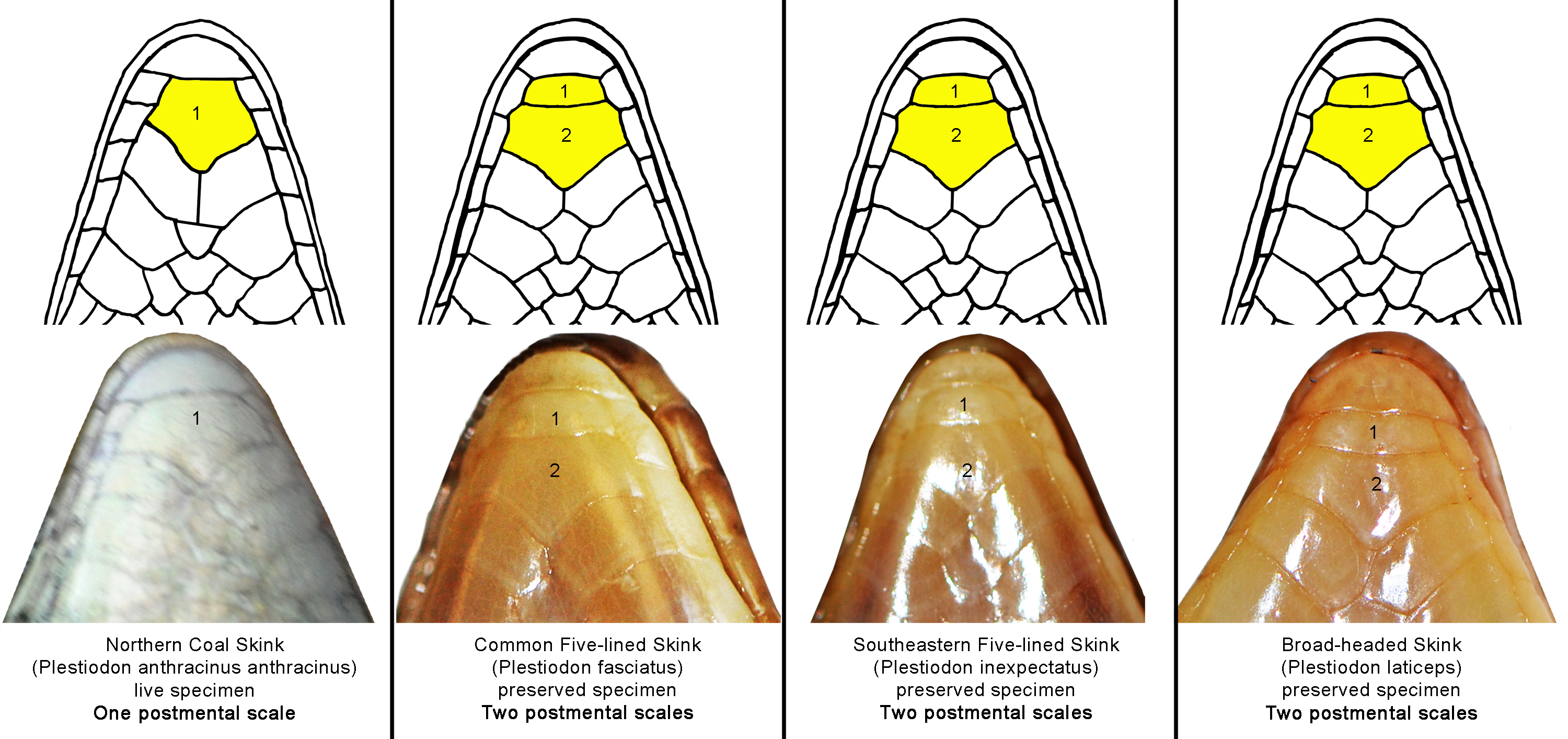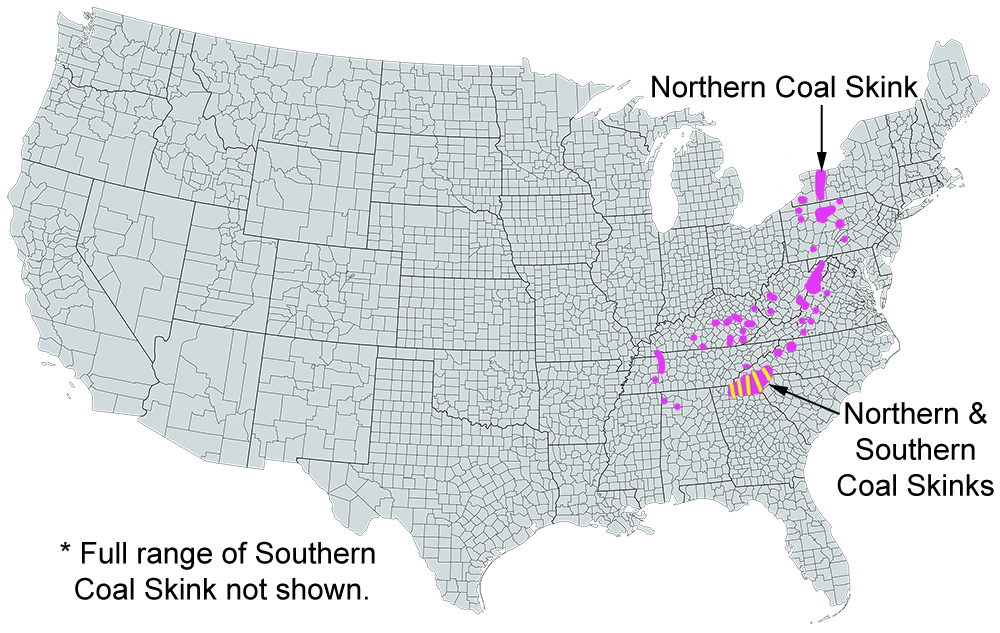Northern Coal Skink
Plestiodon anthracinus anthracinus
Common Name: |
Northern Coal Skink |
Scientific Name: |
Plestiodon anthracinus anthracinus |
Etymology: |
|
Genus: |
Plestiodon is derived from the Greek words pleistos meaning "most" and odontos meaning "teeth". Plestiodon = Toothy Skinks. |
Species: |
anthracinus is derived from the Greek word anthraco meaning "coal", and the Latin suffix inus meaning "pertaining to", referring to the coal like color on the sides of this skink. |
Subspecies: |
anthracinus is derived from the Greek word anthraco meaning "coal", and the Latin suffix inus meaning "pertaining to", referring to the coal like color on the sides of this skink. |
Average Length: |
5 - 7 in. (12.5 - 17.8 cm) |
Virginia Record Length: |
5.6 in. (14.3 cm) |
Record length: |
Systematics: The coal skink was first described as Pleistiodon anthracinus by Spencer Fullerton Baird in 1850 from five specimens collected at "North Mountain, near Carlisle," Cumberland County, Pennsylvania. McCoy (1982) could not find North Mountain in the vicinity of Carlisle and suggested that the type locality should have been listed as "South Mountain." Cope (1900) was the first to use the genus Eumeces for this species. In the Virginia literature, Hoffman (1945a) used Leiolopisma unicolor for this lizard. Two subspecies are recognized: E. a. anthracinus (Baird) and E. a. pluvialis Cope. Conant and Collins (1991) illustrated the distributions of these subspecies. Taxonomy for Plestiodon follows Taylor (1935, Univ. Kansas Sci. Bull. 23: 1–643) and Brandley et al. (2012, Zool. Jo. Linn. Soc. 165: 163–189). Only the nominate subspecies occurs in Virginia.
Description: A medium-sized skink reaching a maximum snout vent length (SVL) of 70 mm (2.8 inches) and a maximum total length of 178 mm (7.0 inches) (Conant and Collins, 1991). In Virginia, maximum known SVL is 57 mm and maximum total length is 143 mm. Tail length in the present study was 53.6- 62.1% (ave. = 57.6 ± 4.3, n = 3) of total length.
Scutellation: Body scales smooth, overlapping, and glossy; scale rows around midbody 23-26 (ave. = 24.5 ± 0.9, n = 11); scale rows around tail 10 scales posterior to anal plate 13-16 (ave. = 14.8 ± 1.0, n = 8); subcaudal scales along midline of venter wider than long; supranasals present; frontonasal separated from rostral by a pair of supranasals; supralabials 7/7 (45.4%, n = 11), 6/6 (27.3%), or 6/7 (27.3%); 1-2 enlarged postlabials; labial scales between rostral and first supralabial entering eye (= preorbital supralabials) usually 4 (68.8%, n = 16, sides counted separately) but occasionally 3 (31.7%); postnasals absent; infralabials 6/6 (81.8%, n = 11) or 5/6 (18.2%); mental single; postmental 1.
Plestiodon Chins:

Coloration and Pattern: Broad tan to brown middorsal stripe on body and tail bordered by light dorsolateral stripes; 4 scale rows between scales bearing dorsolateral light stripes; light dorsolateral stripe extends from eye onto tail; side of body dark brown to black bordered by the dorsolateral stripe and a lower lateral stripe; lateral light stripe extends from the posterior supralabials through ear opening to hind legs; a faint middorsal stripe may be present in some individuals but usual total number of distinct stripes 4; venter cream to light blue in immatures changing to black in adults; light lines on dorsum of head absent; snout brownish; anterior chin white.
Sexual Dimorphism: The sides of the heads of adult males in the mating season are reddish or or- angish, otherwise adults of both sexes have similar colors and patterns. Adult females (ave. 56.7 ± 0.6 mm SVL, 56-57, n = 3) averaged larger than adult males (51.5 ± 5.2 mm SVL, 48-59, n = 4). Sexual dimorphism index was 0.10.
Juveniles: Juveniles are colored and patterned as adults except for the blue tail. Hatchlings from a clutch laid by a female from Virginia averaged 22.3 ± 0.6 mm SVL (21.3-22.9, n = 5).
Confusing Species: The three other Plestiodon have 5 distinct stripes, especially in the size range encompassing adult Northern Coal Skinks (<70 mm SVL). All other Plestiodon have 2 postmental scales. The Little Brown Skink (Scincella lateralis) has dark dorsolateral stripes and has the frontonasal scale broadly in contact with the rostral scale.
Geographic Variation: Geographic variation among the Virginia localities cannot be assessed because of the small sample sizes available. Mount (1975) noted that the Southern Coal Skink (P. a. pluvialis) in Alabama has a higher number of midbody scale rows (25) than the northern subspecies and has dark stripes or spots on dorsum; juveniles are black without stripes. The middorsal stripe in Northern Coal Skinks from Pennsylvania is bronze (McCoy, 1985).
Biology: The biology of this secretive, terrestrial skink is little known. The following habitats have been noted by its collectors in Virginia: limestone ledge in deciduous montane forest (Hoffman, 1944a); "in a bed of dried leaves beneath a rock ledge," presumably in deciduous forest (Telford, 1955); beneath flat slabs of sandstone (Hoffman, 1986); under rock on a slope with some grass in a cutover hardwood forest (C. A. Pague, pers. comm.); and under rocks on the slope of a roadcut in mixed hardwood-pine forest (D. A. Young, pers. comm.). Conant and Collins (1991) noted that Northern Coal Skinks inhabit humid portions of wooded hillsides. In general, P. anthracinus is a montane lizard found in forested areas with rock cover and sunlit openings. Virginia specimens have been collected in March (2), April (6), May (2), and June (1).
Northern Coal Skink are predators of insects and other invertebrates. Hoffman (1944a) reported that a captive juvenile from Alleghany County ate earthworms and that he found remains of small beetles under the rock where it was found. A juvenile female from Albemarle County had eaten a small salticid spider and a small wolf spider. One juvenile male from Augusta County had consumed a small grasshopper, and four adults had each consumed terrestrial spiders. Natural predators of this skink are unknown.
Female Northern Coal Skink are oviparous. Mating has been observed on 10 May in Alabama (Mount, 1975). The smallest adult male I measured was 48 mm SVL and the smallest adult female was 57 mm SVL. Males of 40 and 45 mm SVL and females of 38 and 44 mm SVL were immature. Based on re ports from Alabama, Kansas, and New York, eggs are laid late April through late June; clutch size based on several sources is 4-11 eggs; and hatching is from the end of May through late July after an incubation period of 4-5 weeks (Smith, 1946; Mount, 1975; Collins, 1982). A female from Botetourt County contained seven oviductal eggs on 29 May and one from Augusta County contained nine enlarged follicles in April (no specific date). A female from Augusta County laid eight eggs on 16 June. These averaged 10.4 ± 0.4 x 7.1 ± 0.5 mm (length 9.7-10.9, width 6.5-7.8) in size and weighed 0.22-0.32 g (ave. = 0.28 ± 0.04). Incubation period and hatching dates are unknown for this species in Virginia.
The population ecology of this species has not been studied, no doubt due to the difficulty in finding these lizards. The behavior of this skink is unlike any other. It remains terrestrial when pursued and does not climb. It often enters water to escape predators where it may hide under a rock (Conant and Collins, 1991). Instead of escaping by crawling under leaves, Northern Coal Skink run or wriggle across the top.
Remarks: Another vernacular name in Virginia is black skink (Carroll, 1950).
The first Northern Coal Skink known from Virginia was collected by R. L. Hoffman in Alleghany County in March 1942 and reported by him 2 years later (Hoffman, 1944a). Only 11 specimens are currently available for study. Thus, additional fieldwork is needed to obtain distributional and ecological data on this elusive lizard.
Conservation and Management: The low number of known localities in Virginia renders Plestiodon anthracinus a species of special concern. However, the lack of information on population ecology and threats was the basis for its inclusion in the status undetermined category in Mitchell and Pague (1987) and Mitchell (1991a). These data need to be obtained before realistic conservation and management strategies can be formulated.
References for Life History
Photos:
*Click on a thumbnail for a larger version.
Verified County/City Occurrence in Virginia
Albemarle
Alleghany
Augusta
Botetourt
Craig
Highland
Montgomery
Patrick
Roanoke
Rockbridge
Rockingham
CITIES
Danville
Verified in 11 counties and 1 cities.
U.S. Range







